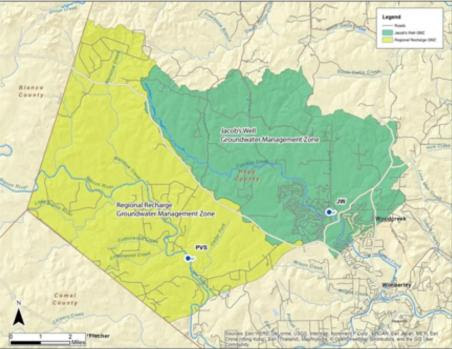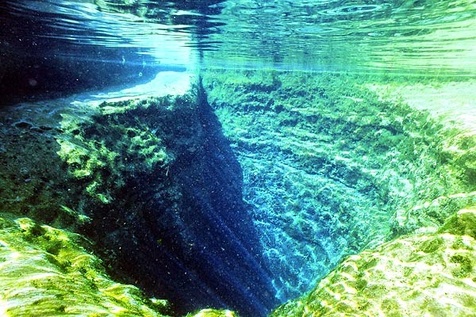
By: David Baker, Executive Director of the Wimberley Valley Watershed Assoc. WIMBERLEY, TX – A new Groundwater Management Zone has been proposed to protect sustainable spring flow from Jacob’s Well into Cypress Creek, often called the lifeblood of Wimberley. A Jacob’s Well Groundwater Management Zone (JWGMZ) was recommended last month by a “Spring Flow” task force formed by the Hays Trinity Groundwater Conservation District (HTGCD). The JWGMZ is located in the upper Cypress Creek Watershed and would cover approximately 32 square miles located around and north of Jacob’s Well – a major part of the Well’s recharge zone – and would apply a series of “best practices” to ensure Jacob’s Well, the source of Cypress Creek, will continue to flow even in drought or heavy usage conditions. “Our groundwater resources are limited,” said Hays County Precinct 3 Commissioner Lon Shell, a member of the special spring flow task force. “They are under stress now and they are going to be under more stress in the future. It is imperative that we come together as a community and understand how we are going to address our groundwater supplies in the future. I think this task force was a good step toward that goal.” The best practices would include: cutbacks on pumping in the zone from permitted water wells based on spring flow “triggers” measured from Jacob’s Well during dry times with low flows; protection measures for the spring and current water supplies would include conditional permits for newly permitted wells, restricting pumping from the Middle Trinity section of the Trinity Aquifer (but allowing permits in the Lower Trinity and also identifying alternative water supplies such as rainwater harvesting); and new incentives for conservation development will be developed by Hays County. “Triggers” are standardized conditions which would be used to initiate and set the degree of pumping curtailments in the zone. For example, if water pressure at Jacob’s Well dropped to specific cubic feet per second (cfs), permitted pumping in the JWGMZ would be decreased by a predetermined percentage. The task force also recommended consideration of a second Regional Recharge Zone located from the south and west boundaries of the JWGMZ to Hays County’s borders with Comal and Blanco counties. This second GMZ would serve to protect groundwater flows to the Pleasant Valley Springs area, which is critical to the health of the Blanco River.” Maintaining spring flow into Cypress Creek and the Blanco River is essential for our local economy and for the health of our regional ecosystems,” said Wimberley Valley Watershed Association (WVWA) Executive Director David Baker, also a member of the task force. “Establishing management zones is something the WVWA has been advocating for since 2010, when an unsustainable 30 feet of drawdown was adopted as a policy by Groundwater Management Area 9 (GMA-9). Just 1-2 feet of drawdown in the Middle Trinity cause Jacob’s Well and Cypress Creek to stop flowing.” “We were already over-pumping the aquifer in 2000 when Jacob’s Well stopped for the first time in recorded history. Even developers and water utilities represented on the task force recognized that keeping the springs flowing at Jacob’s Well and Pleasant Valley – and keeping the water clean and healthy – is a benefit to everyone.” The 35 member volunteer task force was established in August last year and began work in October. The group was selected and invited by HTGCD President Linda Kay Rogers and included landowners, developers, community leaders, government representatives, environmental advocates, technical, science and education professionals and business leaders, including representatives of Aqua Texas and Wimberley Water Supply Corporation. Meetings were run by professional facilitator Robin Rather. Despite the large size of the group and diversity of opinions and motivations of its members – and occasional strong discussions and reassessment – the task force came to 100% consensus on six of its seven recommendations for the proposed JWGMZ, and missed consensus by only two votes on a portion of the seventh recommendation. In that recommendation, all members agreed on the need for the Jacob’s Well GMZ, but two stakeholders did not fully agree with the majority on establishing a GMZ for the Blanco River regional recharge zone that supports flows to Pleasant Valley Springs and Jacob’s Well. “The science says that 80-85% of the spring flow of Jacob’s Well is coming from the Cypress Creek watershed,” said Baker. “But equally important to the Wimberley Valley is the flow of Pleasant Valley Springs and the Blanco River. I hope the HTGCD board will move forward to adopt the overwhelming community support of these recommendations and include a Regional Recharge Zone to give equal protection to the Blanco River and Pleasant Valley Springs.” The findings and suggestions of the task force regarding creating a JWGMZ will be presented to the HTGCD board and the community at its next meeting on July 17 at 5:30 pm at the Hays County Precinct 3 Office located at 200 Stillwater Rd. in Wimberley, TX. However, the July meeting is only a general presentation, not a discussion of details, which will take place at the next meeting in August. HTGCD President Rogers, who has worked a long time to create the task force, expressed satisfaction with its work. “I am pleased. Jacob’s Well plays a key economic role in the Wimberley Valley. The vitality of the spring is important because it feeds Cypress Creek and all the little springs that come off of it and feed the wells in the area.” |
